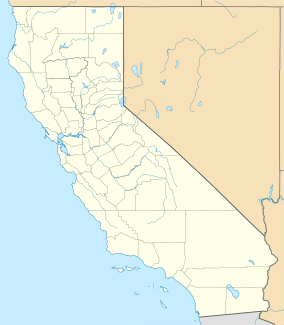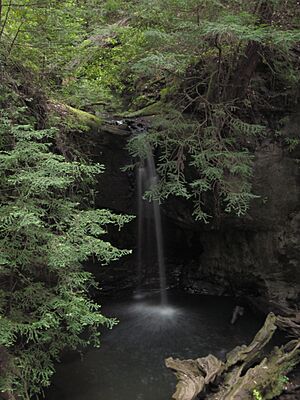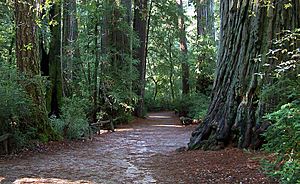Big Basin Redwoods State Park facts for kids
Quick facts for kids Big Basin Redwoods State Park |
|
|---|---|
|
IUCN Category V (Protected Landscape/Seascape)
|
|

Lush coast redwood forest of Big Basin
|
|
| Location | Santa Cruz County, California, United States |
| Nearest city | Santa Cruz, California |
| Area | 18,000 acres (73 km2) |
| Established | 1902 |
| Governing body | California Department of Parks and Recreation |
| Reference #: | 827 |
Big Basin Redwoods State Park is a special place in California, USA. It is located in Santa Cruz County, about 36 kilometers (22 miles) northwest of Santa Cruz. This park is famous for its giant coast redwood trees. It protects almost the entire Waddell Creek area. This area was shaped by earthquakes lifting the land and many streams carving out a bowl-shaped valley.
Big Basin is California's oldest State Park, started in 1902. It is even a California Historical Landmark. The park has grown from its original 3,800 acres to over 18,000 acres today. It is part of the Northern California coastal forests and has the biggest group of ancient redwood trees south of San Francisco. About 10,800 acres are old-growth forest, meaning the trees have never been cut down. The park also has other types of forests, like conifer and oak trees, and areas with chaparral plants and riparian (riverbank) habitats.
The park's elevation changes a lot, from sea level up to over 600 meters (2,000 feet). The weather can be foggy and damp near the ocean, but sunny and warm on the hilltops. Big Basin has over 130 kilometers (80 miles) of trails. Some trails connect Big Basin to Castle Rock State Park. The Skyline-to-the-Sea Trail goes through the park along Waddell Creek all the way to Waddell Beach.
Big Basin is home to many waterfalls and different environments. You can see many kinds of mammals like deer, raccoons, and sometimes a bobcat. There are also many birds, including Steller's jays, egrets, herons, and acorn woodpeckers.
In August 2020, the CZU Lightning Complex fires burned over 97% of Big Basin. The park headquarters were destroyed. The park was closed for two years for rebuilding. It partly reopened in Summer 2022.
Contents
Park History
People have lived in the old growth forests of Big Basin for a very long time. They used the forest for food, materials for baskets, and hunting. Ohlone tribes lived along the streams that start in the park. In 1769, explorers from the Portola expedition saw the redwoods in this area. They camped near Waddell Creek. Many of them were sick, but they ate berries and felt better quickly. Because of this, they called the valley 'Cañada de la Salud,' which means 'Canyon of Health.'
By the late 1800s, redwood forests were becoming famous but were also being cut down very fast. People who cared about nature, like Andrew P. Hill and Carrie Stevens Walter, wanted to save the Big Basin redwoods. They started a group called the Sempervirens Club. This group worked hard to protect the forest. In 1901, a new law was passed to create the park. In 1902, the land officially became 'The California Redwood Park.' It started with 3,800 acres, mostly old growth forest.
Over the years, more and more people visited Big Basin. The Big Basin Inn offered cabins, a restaurant, and a store. There was also a post office, a swimming pool, and places for boating and tennis. Campsites cost 50 cents a night in 1927, and many families stayed all summer. During the Great Depression in the 1930s, the Civilian Conservation Corps (CCC) helped build things in the park. These men built the amphitheater, many miles of trails, and some buildings still used today. The main administration building, built by the CCC in 1936, was a historic landmark before it was destroyed in the 2020 fires.
In 2020, the Save the Redwoods League bought more land called Cascade Creek. This land connects Big Basin with Año Nuevo State Park.
The 2020 Wildfire
The CZU Lightning Complex fires began on August 16, 2020. They burned over 86,509 acres across Santa Cruz and San Mateo counties. The fire spread very fast, and people had to leave the area on August 18. By August 20, the park's historic headquarters building was completely gone. Most of the campgrounds were also badly damaged. The fires burned for 37 days and were finally stopped on September 22. Over 97% of Big Basin was burned, and almost every building was destroyed.
This was the first big wildfire in Big Basin in over 100 years. The last one was in 1904. Because there hadn't been a fire in so long, the 2020 fire was very strong. It caused a lot of damage to the old growth trees. While some trees fell, most of the ancient redwoods are still standing. However, studies show that only about 24% of the forest is still alive and growing back. This is because the fires were so intense and there was a drought in the years after. The old growth forest might not fully recover.
In April 2021, a tour of the burned area showed the damaged landscape. Many buildings were destroyed, and thousands of charred trees had fallen or were in danger of falling onto trails. It took a long time to clean up and rebuild. The park stayed closed to the public until July 22, 2022. Almost two years after the fire, Big Basin partly reopened eight hiking trails for day use.
Park Plants
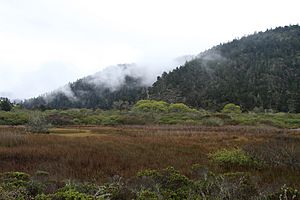
Even though redwoods are the main trees, many other plants grow in Big Basin. You will often see coast Douglas-fir, tan oak, Pacific madrone, and Pacific wax myrtle trees. Many shrubs also grow here, like red huckleberries, western azalea, and different kinds of ferns.
In spring and summer, you can see many wildflowers. These include redwood sorrel, salal, redwood violets, trillium, star lily, and mountain iris. When it rains in fall and winter, hundreds of kinds of fungi appear in many amazing shapes and colors.
As you go to higher parts of the park, the forest becomes thinner. Redwoods are replaced by plants that can handle drier weather. The higher, drier hillsides of Big Basin often have chaparral plants. Here, you'll find knobcone pines, chinquapin, and buckeye trees. Below them grow dense, low shrubs like ceanothus, manzanita, chamise, and chaparral pea. Wildflowers like Indian paintbrush, monkey flower, bush poppies, and yerba santa add bright colors.
Near the mouth of Waddell Creek is the Theodore J. Hoover Natural Preserve. This is a rare freshwater marsh that has not been disturbed much. It is a special home for many birds, reptiles, and amphibians. The nearby Rancho Del Oso Nature and History Center teaches visitors about the history and nature of this area.
Park Animals
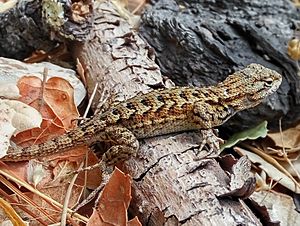
You can often see mammals like black-tailed deer, western gray squirrels, chipmunks, and raccoons. Foxes, coyotes, bobcats, and opossums also live here. Cougars are known to be in the park but are rarely seen.
Grizzly bears used to live in California but are now extinct here. In 1875, a lumber mill owner named William Waddell was killed near Waddell Creek. This was the last known time a person died from a grizzly bear in the wild in California.
Many birds live throughout the park. You will see and hear Steller's jays and acorn woodpeckers. The dark-eyed junco is also very common. Other birds that are harder to spot include the brown creeper, Anna's hummingbird, northern flicker, olive-sided flycatcher, and sharp-shinned hawk. The first ever nest of a marbled murrelet was found in Big Basin. These robin-sized seabirds nest high in the oldest coast Douglas-firs and redwoods to feed their young. You might see or hear them at dawn and dusk, flying high above the forest.
Many reptiles are also in the park. The western fence lizard is seen often. Most other reptiles are shy and rarely seen. The only dangerous reptile in the park is the Pacific rattlesnake (Crotalus oreganus). It is found mostly in the high, dry chaparral areas.
The damp, shady forest floor is home to many amphibians. Common ones include the California newt (Taricha torosa torosa), Pacific tree frog (Pseudacris regilla), and arboreal salamander (Aneides lugubris). Less common are the black salamander (Aneides flavipunctatus) and California giant salamander (Dicamptodon ensatus). The threatened California red-legged frog (Rana draytonii) also lives here. A very interesting animal is the banana slug (Ariolimax spp.), which can grow up to 6 inches long!
You might also see California sisters (Adelpha bredowii) fluttering high in the tree branches.
Camping in Big Basin
Big Basin Redwoods State Park offers different ways to camp. These include cabins, regular campsites, and trail camps. Before the 2020 fires, the park had 146 campsites, 36 cabins, and five trail camps. Campers could bring dogs to their campsites if they were on a leash. Dogs were not allowed in trail camps.
Each campground at Big Basin Redwoods State Park used to have its own schedule. Huckleberry and Sequoia Campgrounds were open all year. Blooms Creek, Sempervirens, Watashi, and Sky Meadow Campgrounds were open only during certain seasons.
Big Basin Redwoods State Park has five backcountry trail camps. You need a permit to use these. Some of these campsites are on the Skyline-to-the-Sea Trail. Hikers can use them with the right permissions.
The 2020 CZU Lightning Complex fires destroyed many campgrounds. As of Summer 2024, none of them have reopened yet.
How to Get There
The park is about two hours south of San Francisco. You can reach Big Basin from the east, driving through redwood forests and coastal mountains. Or you can come from the coast, along State Route 1. The eastern route, using State Route 9 through towns like Saratoga and Boulder Creek, is popular because of the famous trees. This route also passes Castle Rock State Park (California).
From State Route 1, Gazos Creek road is a nice route for mountain bikes (cars are not allowed). You can then go down into the park's main area or turn onto Johansen fire road.
After the park reopened following the CZU Lightning Complex fires, the Santa Cruz Metropolitan Transit District added more bus trips on route 35. These buses now run to and from the park on weekends.
Big Basin in Movies
Big Basin has been used as a filming location for movies.
- In the 1942 film The Forest Rangers, Big Basin was the fictional "Bolderoc National Park."
- It was used for Muir Woods in the 1958 Alfred Hitchcock film, Vertigo.
- It also stood in for Redwood National Park in the 1967 Disney film, The Gnome-Mobile.
Images for kids
-
The Skyline-to-the-Sea Trail passing through a stand of California redwood trees.
-
The Skyline-to-the-Sea Trail passing through a fallen California redwood tree.
-
The Skyline-to-the-Sea Trail passing over Waddell Creek.


